 Madrid, Spain
Madrid, Spain
 |
Madrid, the capitol of Spain, is located pretty much in the center of the country. It's also the highest of all European capital cities (COLD in the winter). Built during the height of Spanish power, it shows off the grandeur of the times. From grand palaces, to century old museums, to expansive plazas and parks, there are tons of things to see and do in this great city. Madrid rivals Paris, London, and Rome in number of attractions, and certainly parties a lot more than the others.
That's one thing we found out about the Spanish. They LOVE to party. Dinners are notoriously late, and people don't even start going out until after midnight. They'll be out partying all night, and return only after the sun rises. I haven't seen anyone work in this town... I'm gonna love this place!
June, Michelle, and I came in on the same plane from DC, while Scott arrived a few hours later. Tired and jet-lagged from the trip, we spent the first day finding our way from Barajas Airport into town, and getting settled into our hotel, which was conveniently located near the heart of Old Madrid -- Plaza Mayor and Puerta del Sol.
Our first night in town. We decided to take a stroll to explore our immediate surroundings on foot. As we shall see in the days to come, we find people everywhere late at night, partying. We came upon the annual Christmas Festival in Plaza Mayor, with tons of people in shiny wigs and sparklers running around.
this picture shows the darkened equestrian statue (built in 1616) of Philip III in the center of the square. The horse lifts one front leg in the air, indicating that the rider died of wounds received in battle. Had he been killed on the battle field, both front legs of the horse would be airborne. The rest of the square is lit up in the background. The scaffolding was there for some kind of concert, which we unfortunately missed. I'm told during the summer, this is a great place to watch people since it's the heartbeat of Madrid.
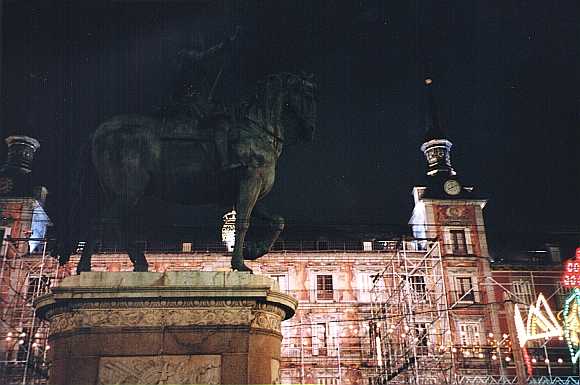 |
Strolling along Calle Mayor toward the palace, the camera catches Michelle peering into the night-time traffic. All the main streets were decorated with festive lights for the holiday season.
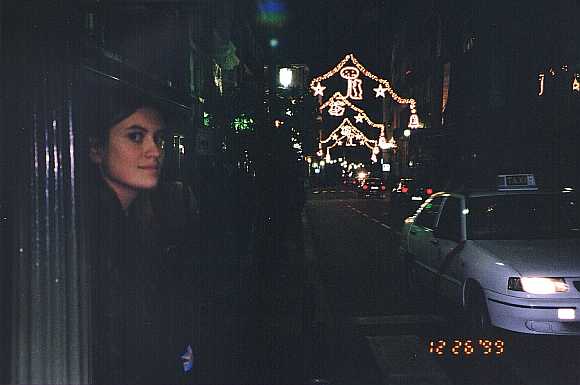 |
Near the palace, we find a gorgeous church called San Jerónimo el Real. This was King Philip II's favorite church, and he built Calle Mayor just to provide easy access to it. Here are San Jerónimo's clock towers all lit up at night. Nice columns and sculptures on the upper level, with a statue of Mary crowning the edifice.
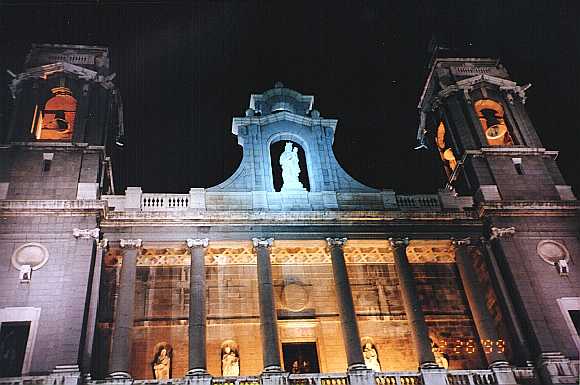 |
The main entrance to the church boasts an elaborate bronze door. Here's Scott checking out the intricate details on the door. We were pretty tired at this point, and decided to go back to rest. But first, we had to stop and sample some churros and chocolate sauce -- something we would constantly crave in the weeks to come. The churros aren't the stiff sugary ones we see here in the States. They are light and fluffy, and they soak up thick chocolate sauce very well.
 |
Bull fighting is one of Spain's oldest and most celebrated traditions. Almost every town has a bull fighting arena. We set out to find the one in Madrid on our second day, and here it is! This is the Plaza Monumental de Toros de las Ventas, the most important bull ring in Spain. Only the best matadors perform here. No luck on trying to enter it since bull-fighting is out of season. Looks like the circus has set up camp there instead.
A traditional Spanish breakfast followed our trip to the bull ring. We had tortilla españa (potato omelette) and churros with chocolate sauce. Yum!
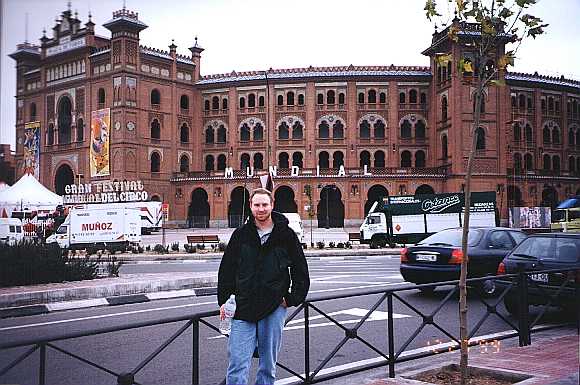 |
Next, it's off to Palacio Real, the royal palace. Palace guards on horses and on foot protect one of the entrances. Hey Scott and Michelle, I'll give you 20 bucks if you take off running toward the entrance, screaming obscenities!
 |
A shot from inside the palace. Note the richly decorated walls and arches, as well as the many statues. The palace was built in 1738 on top of the old Madrid Alcázar, which burned down in 1734. The 2,000 rooms in the grand palace are stuffed with treasures.
 |
A cool picture of the Throne Room in the Royal Palace. We weren't allowed to take pictures in there, but that's why they make postcards!!!
 |
Time for lunch. We found this cool little restaurant next to our hotel, emphasis on "little". Here's me squished into a corner. Guess they didn't want the tourists to get in the way of their regular customers!
I'll soon realize that Spain offers some of the best seafood dishes in Europe. The grilled fish I had at this place was amazing! Lunch consisted of potato and rib soup, grilled fish, bread, wine, and dessert -- a feast for 1000 pesetas (about $5).
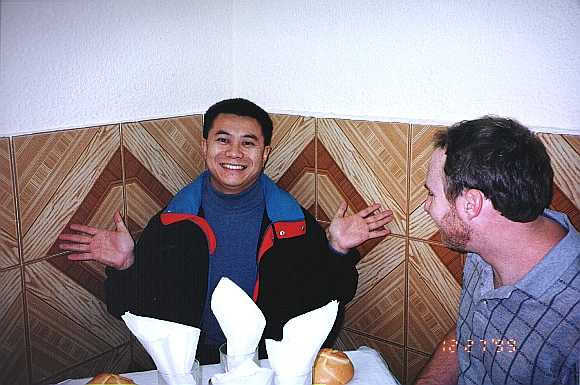 |
The sisters June and Michelle at Plaza de la Cibeles, the most beautiful square in Madrid. The Plaza is known for its picturesque fountain (Fuente de Cibeles) in the middle showing the Roman goddess Cybele driving a lion-drawn carriage. The fancy building in the background is the most magnificent post office in Europe -- Palacio de Comunicaciones. Gee, our post offices don't look like that!
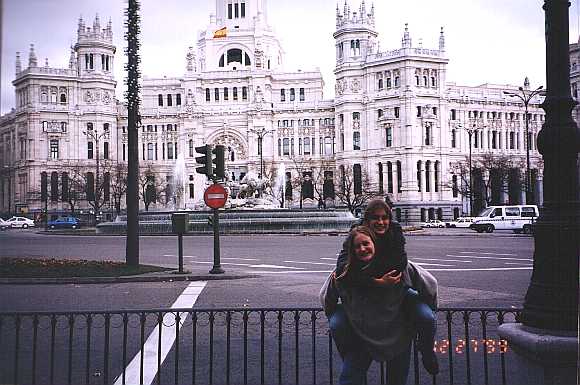 |
Parque del Retiro is the largest park in Madrid. We found the winter park scene to be sparce, but it was strangely inviting. Here we are, in front of the monument dedicated to King Alfonso XII built in 1922. Supposedly, there's also a statue dedicated to the devil somewhere in this huge 350-acre park (at least that's what my guide book says), but we never ran across it.
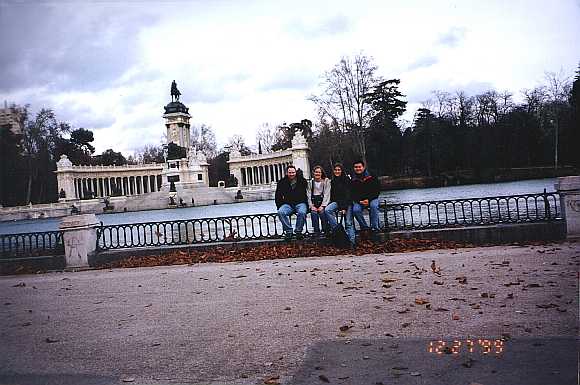 |
We found some time to rent a rowboat and enjoy the lake. The wind was a bit chilly on the water, but not too bad. Boating was fun. Here are Scott and I rowing the girls around.
 |
A silhouette of Michelle against the setting sun.
 |
A note about Spanish cuisine. They love ham (jamon)!
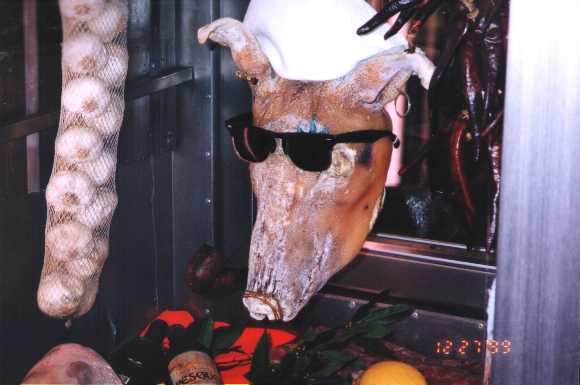 |
When I said that Puerta del Sol is the center of Madrid (and of Spain), I meant it literally. The mileage markers in all of Spain start from this place. Here is the "Km 0" plaque marking the center of Spanish highway system. The text means "origin of the radial highways."
 |
The following few photos were taken in the Prado, the Spanish version of the Louvre in Paris. With more than 7,000 paintings, it's one of the largest and most important museums in the world, showcasing Spanish masterpieces by Velásquez, Goya, El Greco, as well as works by masters from around the world.
I don't recall what this painting is called or who made it but it strikes me as odd. Seems like a strange way to take your milk in the morning.
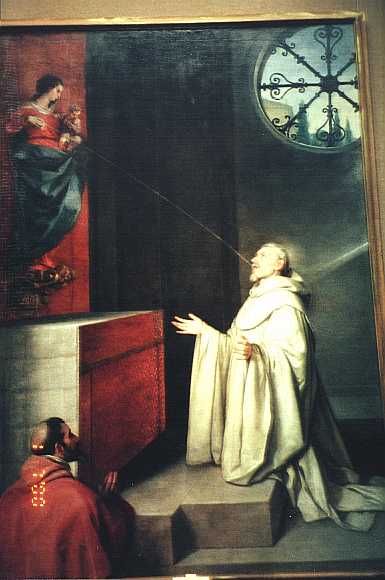 |
The famous "Third of May" painting by Francisco de Goya (1814). It pictures the execution of patriotic rebels by the French on May 3, 1808. The Prado expains: "This painting has been considered as the greatest symbol of independence and of the defense of liberty of the Spanish people."
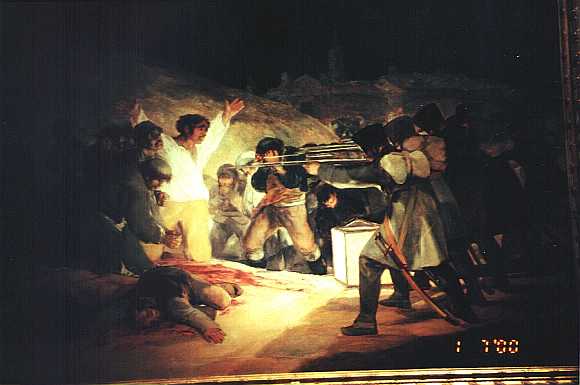 |
This painting "Second of May", also by Goya, accompanies the previous one. It shows the insurrection of the patriotic rebels against the oppressive French invaders on May 2, 1808.
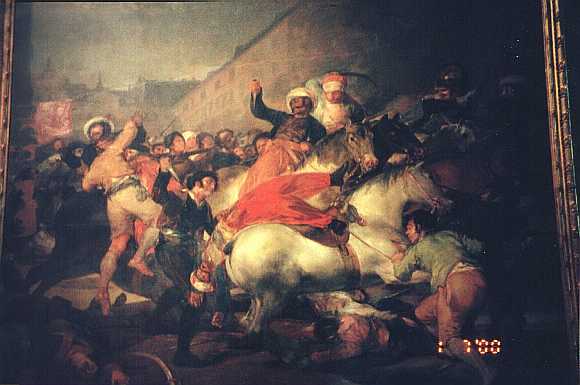 |
Francisco de Goya's unflattering painting of King Charles IV and his family. He painted the royal family in less than regal settings, showing the family presided over by Queen Maria Luisa instead of the king.
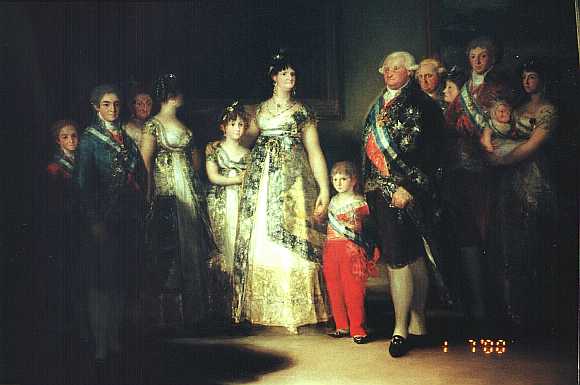 |
Just to show that the Prado isn't all about Spanish paintings, here's an excellent sculpture by famous Italian sculpter Antonio Canova.
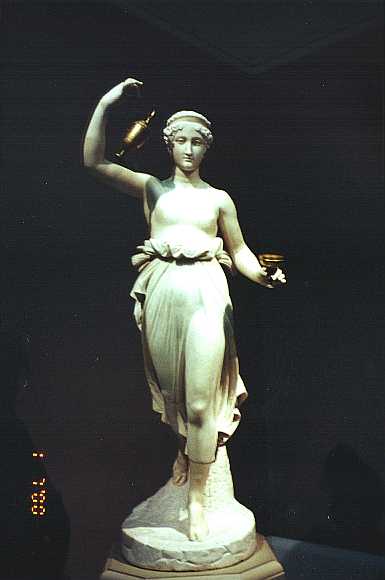 |
I just like this painting. It's a river front scene in Venice showing the tall clock tower, the domes of Basilica di San Marco, as well as the Palazzo Ducale in Piazza San Marco. You can also check out my '98 Venice photos and my '99 Venice photos
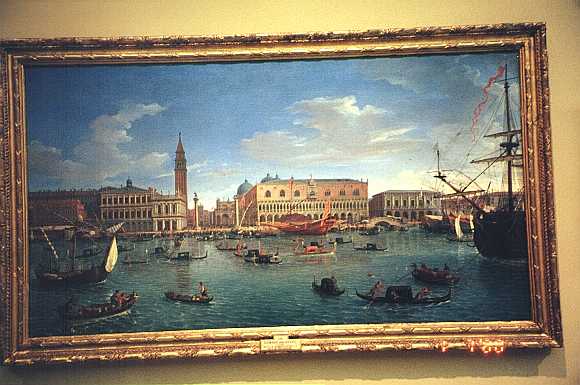 |
Did I mention the Spanish like ham? This is a picture from inside Museo de Jamon. No, it's NOT a museum. It's a chain of restaurants featuring ... (you guessed it) Jamon! This was to be our last meal in Spain since it was taken on our way out and our second visit to Madrid.
 |
The Spanish equivalent of Arc de Triomphe, Puerta de Alcalá, is located in Plaza de la Independencia. It's designed by Francesco Sabatini and completed in 1778. The richly decorated arches became a symbol of the Bourbon enlightenment that swept over Madrid at the time.
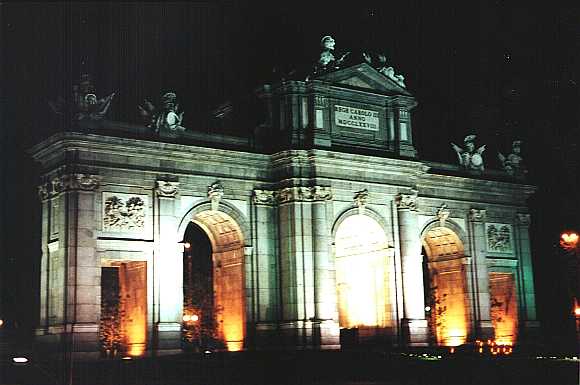 |
| Next | Index |